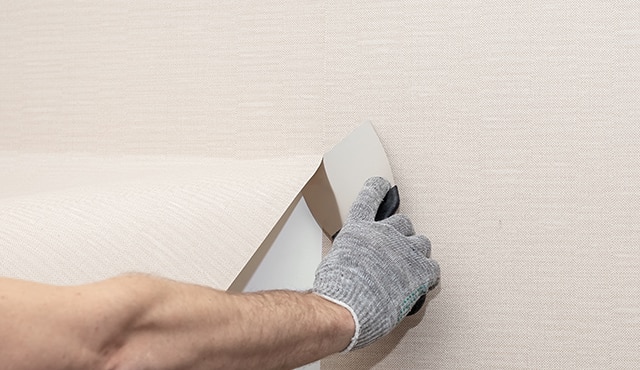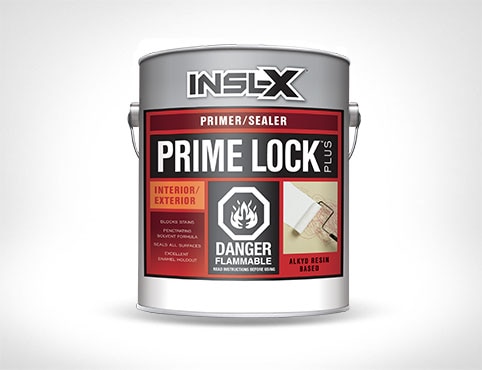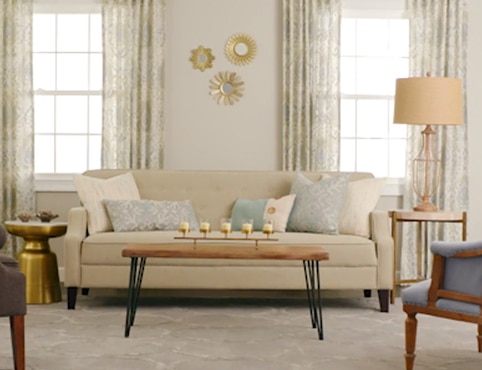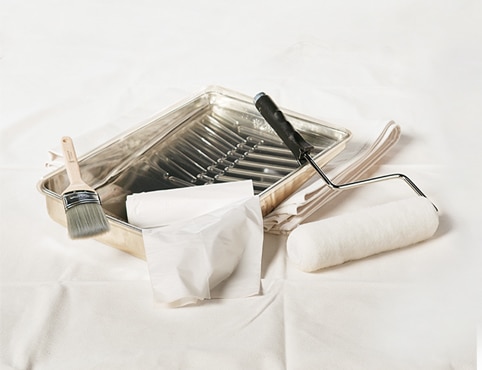Step #1: Prep Your Space
Start by removing all wall hangings and nearby furniture. Cover the floor with a drop cloth, and tape off any electrical outlets, moulding or baseboards.
Wallpaper typically has two components:
- The surface layer: Wallpaper comes in a variety of material types like vinyl, grass cloth and bamboo. It isn’t always “paper.”
- An adhesive layer: An adhesive is used to affix the wallpaper to the wall.
You’ll need to remove both layers to properly prep your walls for painting after wallpaper.
Step #2: Score the Wallpaper that Couldn’t Be Peeled Off
Remember, not every wallpaper removal job is the same—the type of wallpaper, the strength of the adhesive underneath, and other variables can play a role in the outcome. Whether your wallpaper is bamboo or vinyl, strippable or peelable, it’s all held up by an adhesive underneath. The best way to remove wallpaper is to release and take off the wallpaper and adhesive from the wall.
To get started, use a wallpaper scoring tool in a circular motion. The teeth of the round scoring tool will make shallow cuts to allow for your adhesive-removal solution to re-activate and soften the adhesive, without causing damage to the wall.
Helpful Tip
Despite your best efforts, invisible-to-the-eye adhesive may be left behind. Just make sure that the walls are smooth (lightly sand if needed); the recommended primer, INSL-X® Prime Lock Plus, will seal any residual adhesive prior to painting.Step #3: Choose Your Adhesive Remover
When it comes to removing wallpaper adhesive, you have a few options:
- Buy a store-brand chemical solution, like DIF liquid or gel wallpaper stripper.
- Try a homemade solution, like 1/4 fabric softener to 3/4 warm water, or 1/3 household vinegar to 2/3 warm water.
- You might only need a bucket of warm soapy water and a sponge. Talk to your local Benjamin Moore retailer about selecting the best solution for you.
Gel vs. Liquid: If you are using a store-bought solution like DIF, a gel-based wallpaper stripper is a less messy option than a liquid solution.
Important
Safety Note
Safety Note
Consider using protective eyewear during the adhesive removal process.
Step #4: Peel the Wallpaper and Remove Adhesive
Now it’s time to remove the paper.
- Carefully peel the wallpaper up with a rounded putty knife starting in a corner, near the ceiling or under a switch plate. In the best-case scenario, the wallpaper comes off in large sheets. If your wallpaper comes off in tiny pieces at a time, gently pull it downward or slowly scrape it off the wall.
- Next, apply the wallpaper removal solution to your wall using a pump sprayer, spray bottle or a sponge. If your solution requires warm water, the hotter the water, the better. Just be sure to use gloves for comfort and safety.
- Allow the solution to sit on the surface for 10 to 15 minutes, making sure to keep the wall damp. Using your putty knife, start at an edge, and gently begin to lift the paper from the wall.
- Have patience! Depending on the type of paper and adhesive used, you may find that the paper only comes down in small pieces. If this happens, repeat the process to help soften the adhesive.
Final note: You can rent a commercial wallpaper steamer—just know that these can be costly and difficult to find.
Step #5: Tackle Tricky Adhesive Spots
After you have removed the wallpaper, there may be a few pieces of glue left that are difficult to see. Remove any remaining adhesive spots by going over them again with your cleaning solution and carefully scraping off the leftover wallpaper glue with your putty knife.
You can also sand down any rough spots with fine-grit sandpaper (220-grit) and a sanding sponge. Wipe the wall down with a wet rag as you go. Allow the wall to dry completely.
Step #6: Prime the Wall if You Plan to Paint It
Now you’re ready to prime. After removing wallpaper, we recommend using an oil-based primer like INSL-X® Prime Lock Plus to prep your wall for painting.
For painting, consider Benjamin Moore’s trusted workhorse REGAL® Select Interior paint—or any other Benjamin Moore premium paint. Get help on how to paint interior walls, and check out our how-to video.






